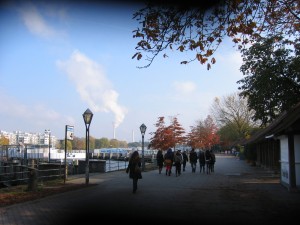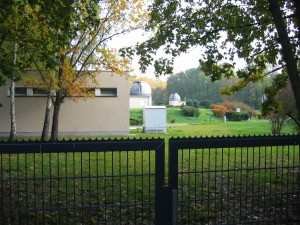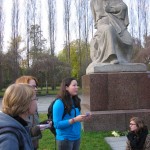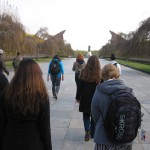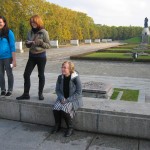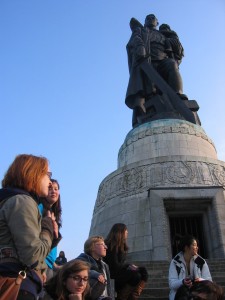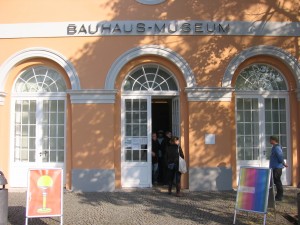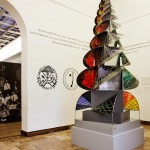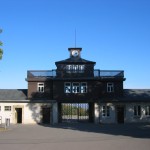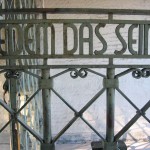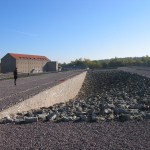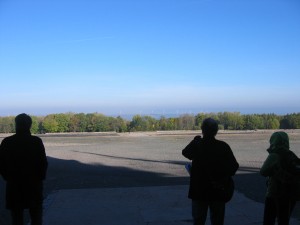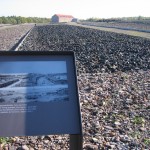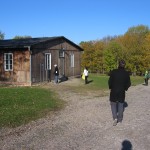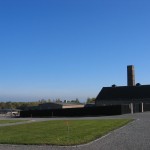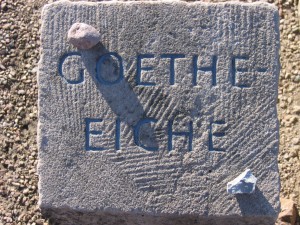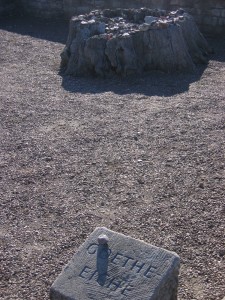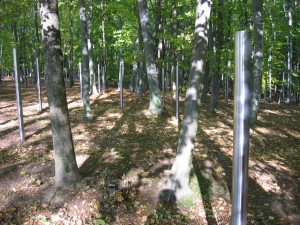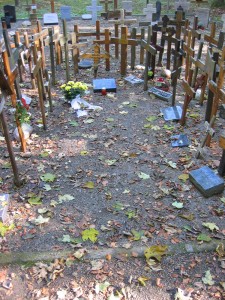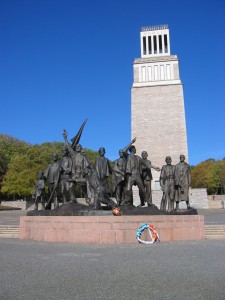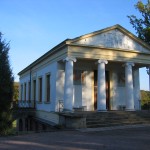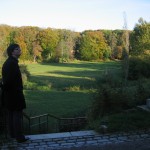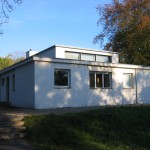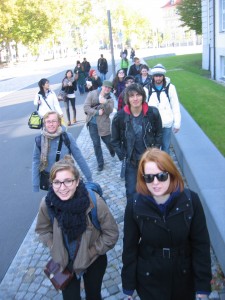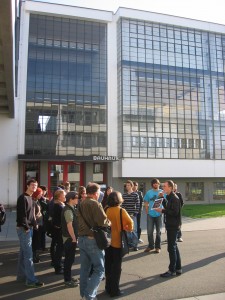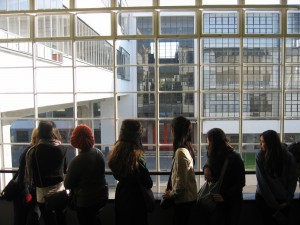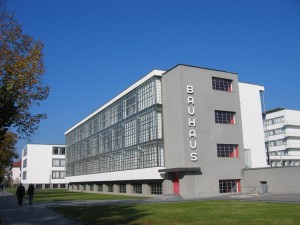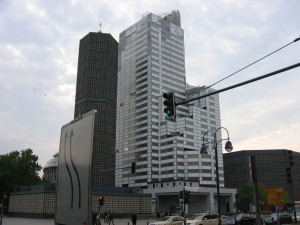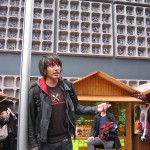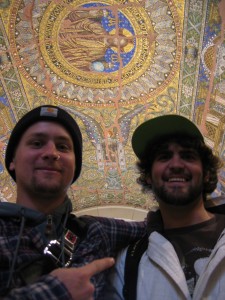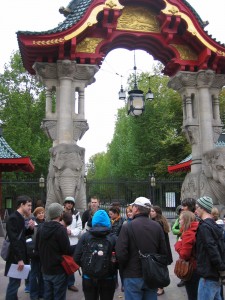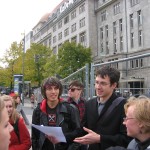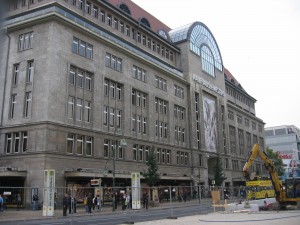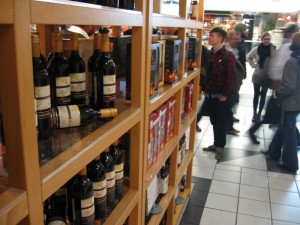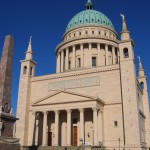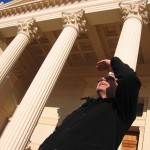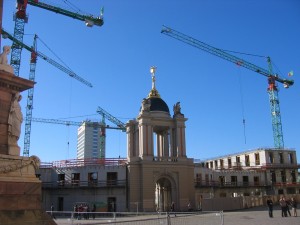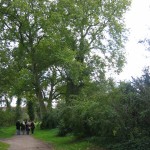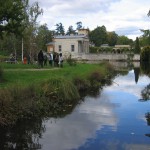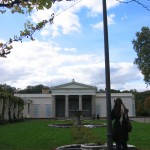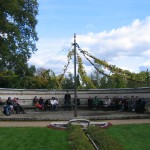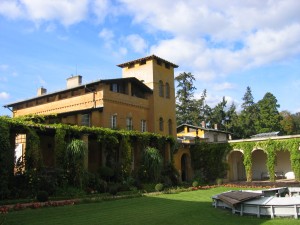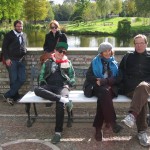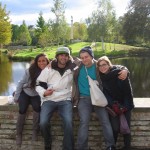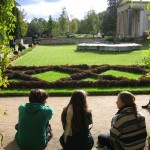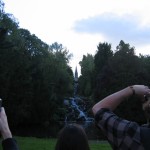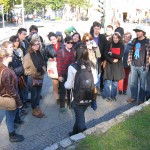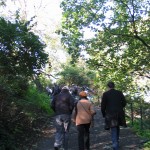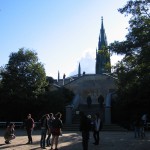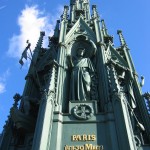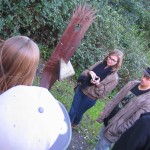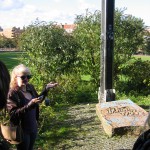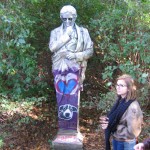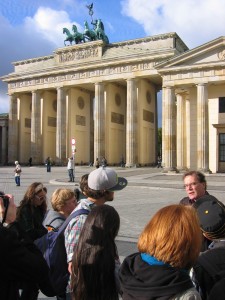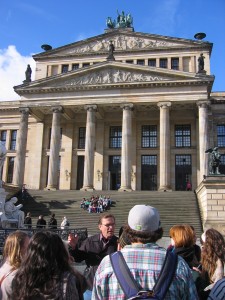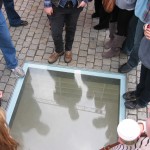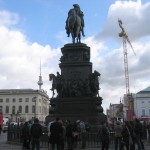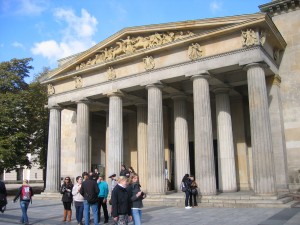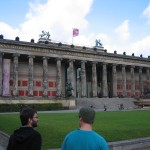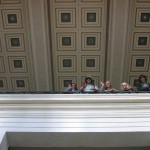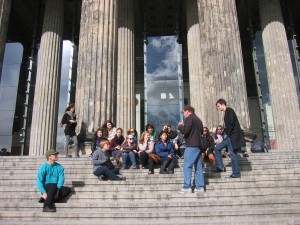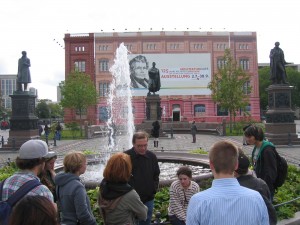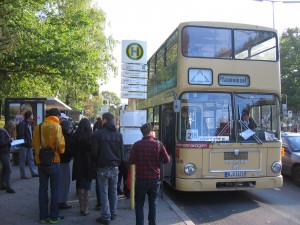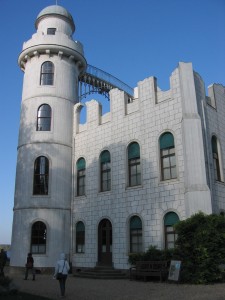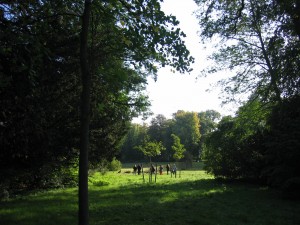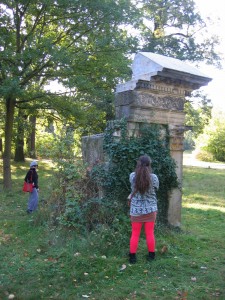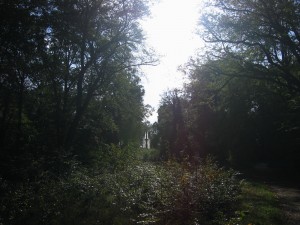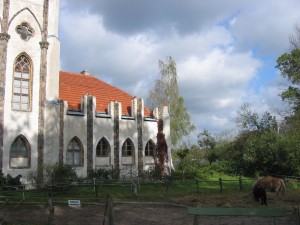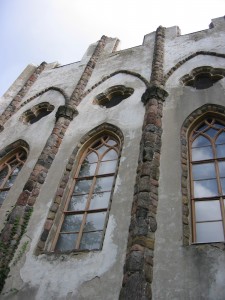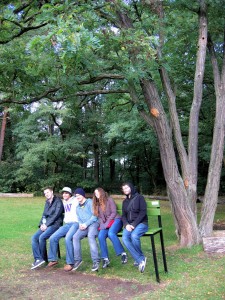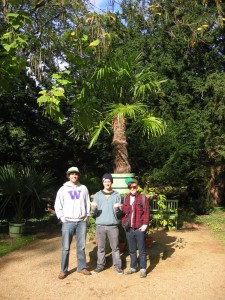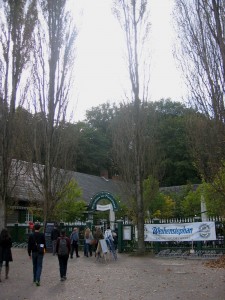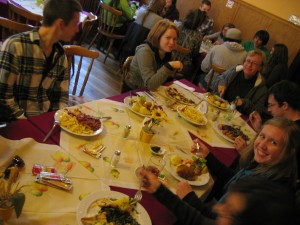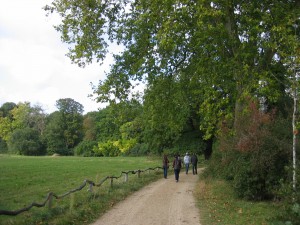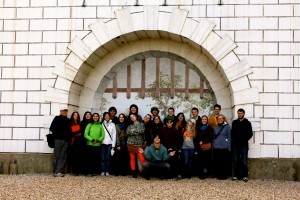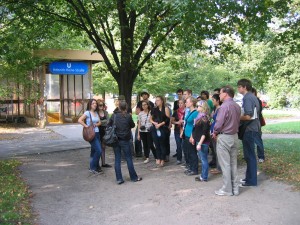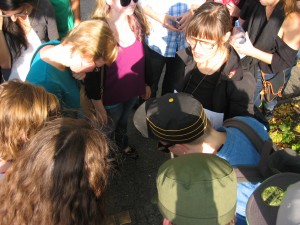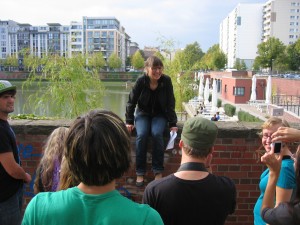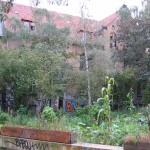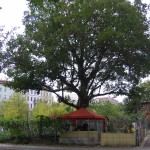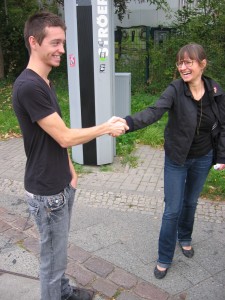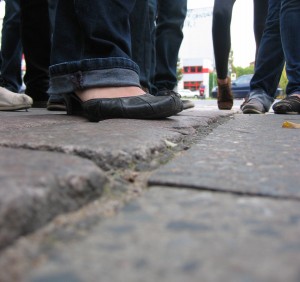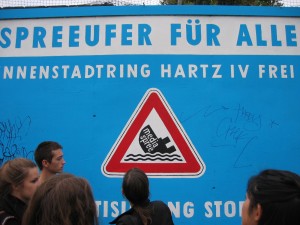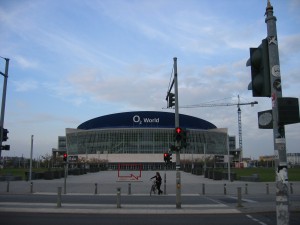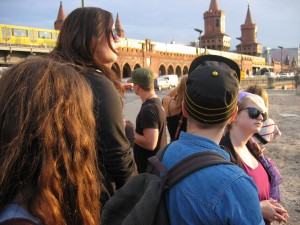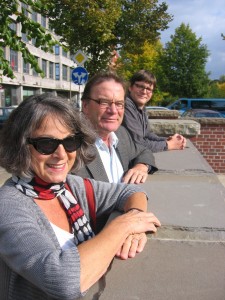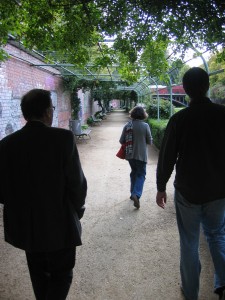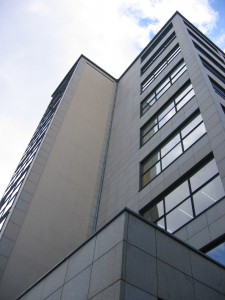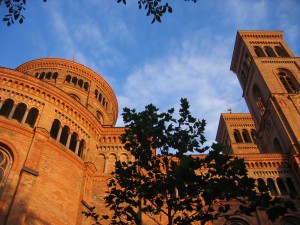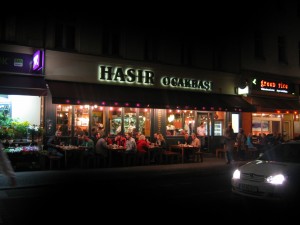Treptower Park with Anna, Mariah and Janet
The student tour this week brought us to Treptower Park, home to …
… houseboats (one of three colonies in Berlin) …
An observatory built for a world’s expo in the park around the turn of the century, and later supposedly used by Einstein …
… and an absolutely massive Soviet World War II memorial and cemetery. Since the park lies in what was formerly East Berlin, it was a natural choice for the Soviets to honor 7,000 of their men who died here. The site is now under the official protection and care of the German government, thanks to a line in the treaty signed by the Soviets in 1989.
The main attraction is a 38-foot statue of a Soviet solder saving a child, posed over a broken swastika. Though it’s a bit over the top, one can’t help but think about the staggering number of men buried here. It’s another sobering facet of Berlin’s complex, and often tragic, history.
A trip to Weimar & Dessau
This weekend we traveled to the beautiful city of Weimar, home of Goethe, Schillar, Liszt, and the birthplace of the Bauhaus! Our first stop on Friday afternoon was the Bauhaus museum – a small but unique little space with treasures from the first years of the school’s existence. Unfortunately the Bauhaus school was forced to leave Weimar after the Nazi party gained power in the state of Thüringen in 1924.
This opened a difficult chapter in Weimar’s history, and on Saturday we visited the nearby site of Buchenwald concentration camp.
The most striking thing one finds on entering the camp is the view: the camp is set in the middle of the forest (Buche means “beech” and Wald means “woods”), on a hill that allows a view across the valley. It’s difficult to believe that such horrible things could transpire amidst such natural beauty.
The original barracks are no longer extant – most are now marked with dark loose stones, but one has been rebuilt in its original form. One of the few other buildings still standing on the grounds is the crematorium, which was strangely located adjacent to a little petting zoo built for the children of the SS.
The Goethe Eiche – Goethe’s Oak – was an oak tree left standing in the camp by the SS. The prisoners named it in remembrance of Goethe’s trips to this same forest. It was damaged in an Allied bombing in 1944 and subsequently chopped down.
Buchenwald was also used as a Soviet internment camp after the war. It’s thought that about 7,ooo people died during this time in the camp’s history, and they were buried in unmarked graves in the woods surrounding the site. Because Thüringen became part of East Germany, the deaths were not acknowledged during the Cold War. The fall of the Berlin Wall finally allowed the victims’ families to speak up and publicly remember their relatives.
The Soviets left another highly visible legacy: a huge memorial to the camp’s liberation, on a hill overlooking Weimar. Buchenwald’s many layers of tragic history gave us much to consider …
The class was free to spend the rest of the day exploring the town. Chance and I took a stroll through the park and admired the “Roman House,” the amazing landscape and the first Bauhaus demonstration house, the Haus am Horn.
Today we left Weimar and headed back to Berlin, with a stop in Dessau to visit the most famous site of the Bauhaus, their school building, designed by Walter Gropius and built in 1925-6. We got a fantastic tour from a very knowledgeable and enthusiastic guide, and I think our students might almost be convinced that Modernism isn’t all horrible … (those of us who study architecture are already sold).
We couldn’t have asked for a more lovely day to see this truly seminal piece of architecture. This week we dive into the study of the specter that haunts both the history of the Bauhaus and Buchenwald: the Nazis and their influence on Berlin and Germany.
Ku’damm, Zoo and KaDeWe with Robert, Dan and Niguel
Our students Robert, Dan and Niguel took us on a great tour of the Ku’Damm/Zoostation area of Berlin this Tuesday. We began just off the Ku’Damm at the Gedächtniskirche – the ruin of a church built by Kaiser Wilhelm II and bombed in 1943. The ruin has become one of the symbols of Berlin, but you can’t see it at the moment – it’s under that ugly white scaffolding you can see in the picture above. Surrounding the ruin are a chapel and belltower designed by the German modernist Egon Eiermann in the 1950s.
We headed into the ground floor of the ruin first. The ceiling still displays some beautiful Byzantine-style mosaics, duly appreciated by our class …
We then headed next door to the Eiermann-designed chapel. Though the newer buildings aren’t much to look at from the exterior (Berliners have nicknamed them the “lipstick and powder box”), the chapel is pretty stunning on the interior. We caught the organist practicing, which added to the atmosphere.
Our next stop was the zoo, where our guides not only acquainted us with the incredible diversity of its inhabitants – the most in the world! – but related the heartbreaking story of Knut, the baby polar bear born in the zoo in 2006. Knut was a media favorite (with good reason – he really was incredibly adorable!), but unfortunately he died earlier this year.
The mood picked back up as we moved to our last stop, the famous Kaufhaus des Westens, or KaDeWe. It’s the biggest department store in continental Europe, with a history that spans over 100 years.
The top floor of the store is known for its incredible selection of foods, both local and imported. And what should we find as we come up the escalators but a little taste of home – Columbia Crest, on sale. It seems we’re not the only Washington imports to Berlin!
A day in Potsdam
Our day trip to Potsdam featured more of our favorite 19th-century designer, Karl Friedrich Schinkel. (You probably think we’re just obsessed with him, but believe us – he truly was great!) We began at the St. Nikolaikirche near the city center. It was begun according to plans by Schinkel, but finished by his student Ludwig Persius.
Berlin isn’t the only city that is rebuilding past monuments – here you can see that Potsdam is also busily rebuilding its royal palace (across from the Nikolaikirche), as a home for the state parliament. Meanwhile, East German buildings on the other side of the square are slated for demolition and replacement.
A trek across Potsdam and through Sanssouci park brought us to another Schinkel site, this one built for a very elite audience – the crown prince.
Schinkel built a tiny summer palace (really the size of a summer home) for the prince, who was a prolific artist and designer himself. Together, they fashioned what the prince referred to as “Siam” – a utopian space filled with rich symbolism, much of which is now lost on those of us without the proper classical education!
Schinkel also designed a house for the court gardener, which later became a billiards room, tea lounge and general garden leisure space for the prince and his friends.
We took some leisure time ourselves – to contemplate the connection between human constructive activity and that of nature, as Schinkel intended – before heading off on our own walks through the rest of Sanssouci park. Next week: Berlin around the turn of the century!
Viktoriapark walk with Annie, Melissa and Rachel
Our students Annie, Melissa and Rachel took us on a tour of Viktoriapark this week. As they explained, the park is home to the “Kreuzberg” (literally “Cross Mountain”) and gives its name to the surrounding neighborhood. The “Kreuz” – really a monument to the wars of liberation against Napoleon – was designed by this week’s featured 19th-century starchitect, Karl Friedrich Schinkel.
It’s a bit of a climb …
… but it’s worth it! There are beautiful views of the city, and of course, a lovely gothic monument to admire as well.
Schinkel isn’t the only artist to have left his mark (whether officially sanctioned or not) on the park. Our guides showed us an artwork commemorating a recent act of sexual violence in the park, another in honor of the uprising of Communist workers in 1953, and one (a spray-paint-covered statue of Heinrich von Kleist) that attests to one of Berlin’s biggest vandalism issues – graffiti. As in the rest of Berlin, Viktoriapark is packed with history, and our tour guides did a lovely job of uncovering some of that for us.
A walk through Schinkel’s Berlin with John Toews
On Wednesday John took us on a tour of Berlin’s historical district, known as Mitte. The focus of our walk was the city as it was in the 19th century, when its inhabitants included some of the leading intellectuals of the time, and the city styled itself as “Athens on the Spree.” We began at the Brandenburg Gate, designed by Carl Gotthard Langhans in the late 18th century as a kind of propylaea leading into Berlin. Karl Friedrich Schinkel had a hand in redesigning the staff held by the goddess of peace who crowns the monument.
We continued on to Schinkel’s Schauspielhaus (now called the Konzerthaus) on the Gendarmenmarkt, a somewhat early commission and an example of the architect’s turn toward neoclassicism.
On the Forum Fridericianum, a square built under Frederick the Great (whose monument you see on the right), there is now a memorial to the book burnings that took place there in the 1930s. The square is home to the former Royal Library, now housing Humboldt University’s law school. Interestingly, we learned that the book burnings were not carried out by Nazi officials, but rather by zealous student party members.
Next stop: the Neue Wache, a guardhouse designed by Schinkel along Unter den Linden. The building has been the site of numerous memorials over the course of the 20th century, including both East German and reunified German commemorations of World War II.
One of Schinkel’s masterpieces, not only of architecture but of urban planning, is the Altes Museum. Sitting across from the site of the royal Prussian palace (not currently extant), the building housed the first true modern museum in Europe. Schinkel designed it to integrate the viewer’s experience of art with that of the urban environment: he provided a viewing platform on the interior of the building, from which visitors could contemplate the royal gardens, palace, and the cityscape beyond.
The tour wrapped up near the site of Schinkel’s Bauakademie – his architectural and design academy. The building is also considered one of his masterworks, and was unfortunately torn down in the post-WWII period. This nylon-covered scaffolding has been here for years, but there’s no money to rebuild it. Its ghostly presence reminds us of the many memories and layers that reside amongst one another in Berlin’s cityscape.
A day on the Pfaueninsel
On Friday we took a trip about an hour outside of Berlin to a magical place called the Pfaueninsel – Peacock Island – for a class retreat. Our goal wasn’t to engage with official historical narratives so much as to relax and be together in a beautiful natural setting!
After riding the S-Bahn to Wannsee, we got to ride on a classic double-decker bus that took us through the woods to the entrance to the island.
Our first stop on the island was Schloss Pfaueninsel, erected for King Friedrich Wilhelm II and his mistress Wilhelmine Enke in the 1790s. Built from wood, it’s supposed to look like a white ruin on the island of Capri!
Of course, the first thing everyone looked for on the island were the eponymous peacocks – and the students found, and were chased aggressively by – a whole flock of them!
The island contains no end of sublime vistas and interesting architectural follies. It was formerly one of the many pleasure grounds of the Prussian royalty, replete with ridiculous attempts at the picturesque. For instance:
A “dairy” in the form of ruined Gothic church, where the king and his mistress could first play at milking the cows before going upstairs to drink milkshakes in an ornately decorated salon!
The island has some quirky modern works, too …
… and there are allusions to buildings that are no longer there, as well. A palm house designed by Karl Friedrich Schinkel once stood on this site, but it burned down in the late 19th century. A pleasant little palm garden pays homage to the absent building.
Though it was sunny, the weather was quite cold and windy. By lunchtime, we were thankful to sit down in the cozy Wirtshaus zur Pfaueninsel and enjoy some delicious home-style German food. Schnitzel, wild boar, Klopse (meatballs), Flammkuchen and pumpkin soup were all on the menu, accompanied, of course, by generous helpings of potatoes!
As we headed home, I couldn’t help thinking about the royals who had once frequented the island. What were their lives like? How would they have experienced the space? We’ll be finding out more about how they lived this coming week, when we visit Park Sanssouci, home to several royal Prussian palaces.
A walk through our Kiez with Manuela Mangold
Manuela Mangold, a long-time Kreuzberger, gave us a fantastic tour of the students’ “Kiez” in Berlin on Tuesday afternoon. Kiez is a local word meaning “neighborhood,” but it denotes not just a district of the city (in this case, Kreuzberg), but one’s immediate, local surroundings — the place where everyday life is lived.
We started our tour at the Heinrich-Heine-Strasse U-Bahn station, the stop where the students regularly get onto the subway. During the time when Berlin was divided, it was a border crossing used mainly for commercial traffic. Below, the subway station was a “ghost station” — because the wall ran in a zig-zag manner from roughly the southeast to the northwest, trains going from this part of West Berlin would pass under East Berlin on their way to other parts of West Berlin would pass through a completely darkened (and sometimes guarded) station.
Next on our tour was an example of Stolpersteine (“Stumble Stones”), an art project begun in Cologne, but which has left its mark all over Berlin. A form of Holocaust memorial, it marks where victims of the tragedy once lived. People are meant to “stumble” over these on their daily walks, a constant reminder of the importance of remembering the Holocaust, and its impact on life here.
We continued with a look at the path of the Berlin Wall and death strip. Manuela is sitting right between former East and West in the picture! As in most of Berlin, it’s been restored so nicely now that barely a trace of the division remains.
Oppositional culture has been a huge part of Kreuzberg’s identity since the 1970s. Here are two examples of “squatter” culture — both built right up against the Wall. One is a famous house squat, and the other a garden built right in the shadow of the wall, in what was technically East German territory!
We continued along the path of the wall, which is (in some places) marked by a strip of brick set into the ground. (Dominic represented East Germany, shaking hands with a West Berliner!)
Leaving our Kiez and crossing the Spree River, we continued on to talk about the politics of development along the river banks, another area where squatters and other oppositional movements have traditionally made their homes. Now big developers are buying up large swaths of property, driving up rents and bringing a whole new feel to the neighborhood, garnering vehement protest from locals. One glaring example of this is O2 World, a large concert venue whose undeniably corporate aura conflicts tangibly with its surroundings. Its VIP entrance along the river was heavily protested, but got built anyway.
We ended our tour at the Oberbaumbrücke, which was also divided by the Wall. Now, as you can see in the background, the U1 train line can run all the way across it again!
Our Kiez is in some ways the perfect spot for the students, sitting uncomfortably amidst the former East and West, scarred with layers of memory and history – and still transforming before our eyes.
warming up to Berlin
Chance and I met John and his lovely wife Eleanor today in their (and the students’) new Berlin neighborhood, Kreuzberg. It’s a beautiful part of the city, with a lively and diverse feel. Though we spent most of the day taking care of various administrative and technological tasks (it’s always a challenge to get settled into a whole new system of cell phones, internet and ATMs!), we got to enjoy the great fall weather and explore a little of our new surroundings too.
We started out with a walk through the park along the Engelbecken and Luisenstadt Canal.
Like the rest of Berlin, the architecture in this neighborhood is full of contrasts. We admired the Max-Taut-Haus on Oranienplatz, which fits so well into Berlin’s current aesthetic that you might never guess it was built between 1931-33. Max Taut, the architect, was Bruno Taut’s brother. The stately St. Thomas Kirche was constructed in the mid-1860s.
We finished up the evening at Hasir, a delicious Turkish restaurant on the corner of Orianienstrasse and Adalbertstrasse.
The students arrive on Monday, and we’re looking forward to commencing our explorations of this fantastic neighborhood – and the rest of the city – together!
tags
the author
I'm a doctoral student at CUNY Graduate Center. I'm thrilled to be teaching the CHID Berlin program with Prof. John Toews! You can contact me at naraelle [at] gmail.com, or find out more about me at www.naraelle.net.
Blogroll
- Annie Holden's blog
- Cassie Hoeprich's blog
- Dominic Barrera's blog
- Janet Williams's blog
- Mariah Alderete's blog
- Melissa Au's blog
- Robert Hampton's blog
- UW Students Study Abroad Our students Natalie and Cassie are contributing to the official IPE student blog this fall!



